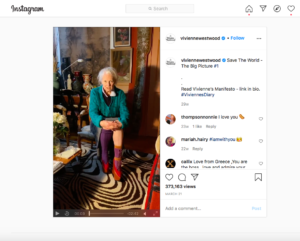How social media is supporting positive changes in the world and why luxury brands should look to their past to build for a better future

By Violaine Gressier, Industry Manager, Luxury at Facebook France.
No one can ignore the ecological emergency we face today. Concerns are growing in the world of luxury, and our clients are asking how we can help them to commit to more responsible luxury practices across our platforms.
Beyond our own environmental-friendly initiatives, the mission that Facebook has embraced is to offer everyone the opportunity to create communities. In response to the huge challenge of sustainable development, it is vital for us to allow people who wish to invest in this cause to connect, communicate and act together. We are convinced that our services have a genuine role to play. Through our platforms, we provide individuals and organisations with solutions that help them to inform, educate and mobilise communities on this major challenge – it is vital that everyone should be able to access, understand and participate in this global debate.
The Facebook Live studios has broadcasted the UN Framework Conventions on climate change since 2016. In 2018, the UN campaign “The People’s Seat”, rolled out on Facebook and Instagram with the hashtag #TakeYourSeat, making it possible to champion the cause amongst heads of state and to over one billion people. Meanwhile, the UN Messenger bot ‘ActNow’ has generated almost 750,000 actions over the last two years. These initiatives show that our platforms can be particularly effective ways of reaching out to the wider population and encouraging people to take action against climate change. Other examples are the climate marches organised around the world and the many advocacy groups that are popping up everywhere. In France for instance, the “Citoyens pour le Climat” collective has created a very active group that now has over 75,000 members.
To provide guidance for organisations, we recently developed a new tool, the “Climate Conversation Map”. This is an interactive map that makes it possible to identify where, when, how and which topics and conversations on climate-related matters are taking place on our platforms.
Luxury brands have recently made fantastic progress on environmental issues. Last year, almost 250 brands signed the “Fashion Pact”, thereby taking one step further towards protecting the climate, biodiversity and the oceans. Firms are investing in fields that offer innovative solutions in response to ecological constraints – such as biotech processes that create leather from plant cells – or services offering more frugal modes of consumption such as rental, exchange or subscription.

Vivienne Westwood
Brands have every reason to take action because the attraction of luxury is now connected to the ethical commitments of companies and consumers alike. Consumers, especially the new generation, increasingly base their purchasing decisions for luxury goods on very strong environmental and social considerations. In 2019, a survey carried out by BCG revealed that over 60% of luxury consumers prefer brands that adopt eco-friendly practices. This increases to 64% for Millennials and Gen Zers. The latter represent the majority of consumers who buy preowned luxury goods. This is a booming market set to experience 12% annual growth.
As we know, these consumers are very active on social media. In France alone, 89% of them use Facebook products every day. Brands must be able to respond to these expectations by communicating in a clear, transparent way about their products and commitments.
Furthermore, although the finger is frequently pointed at luxury brands, they paradoxically meet requirements that are far from incompatible with a more sustainable world. By definition, luxury products are manufactured in small quantities, most often by hand, using traditional expertise. Most importantly, they are made to last. If we want a more sustainable future, it’s important to reconnect with these fundamentals and bring them to the forefront.
Many luxury brands are already using their accounts to voice their ecological commitments, for example, the ethical fashion pioneer Stella McCartney with her #WeAreTheWeather campaign, or Vivienne Westwood with her video series on Instagram TV entitled: “Save the World – The Big Picture”. Young brands such as Reformation and Everlane have created highly committed communities around their eco-friendly approach. Another example is the Weston brand, which has mobilised all of our formats to promote its “Weston Vintage” initiative, a new service offering customers the opportunity to bring their old shoes back to the shop to be restored and given a new lease of life.
These are all examples of how luxury brands can take part in the struggle to protect the planet. There’s a huge amount of work to be done, but one thing is certain: together we can design and roll out large-scale solutions that will benefit communities all around the world. This is why we must join forces and ensure that tools such as Facebook, Messenger, Instagram and Oculus (WhatsApp) help brands to make their voices heard as they strive to build a world that is respectful of the climate and the environment.
References: Facebook, Sustainability Report 2019. Global coalition of fashion and textile firms (ready-to-wear, sport, lifestyle and luxury) and suppliers and distributers who have made a series of ecology-related commitments. Boston Consulting Group, True Luxury Global Consumer Insights, 6th edition, April 2019. Boston Consulting Group & Vestiaire Collective, Why Luxury Brands Should Celebrate the Preowned Boom, October 2019. Facebook IG & Ipsos MORI, Global Report: Understanding Luxury Consumers, November 2019.















